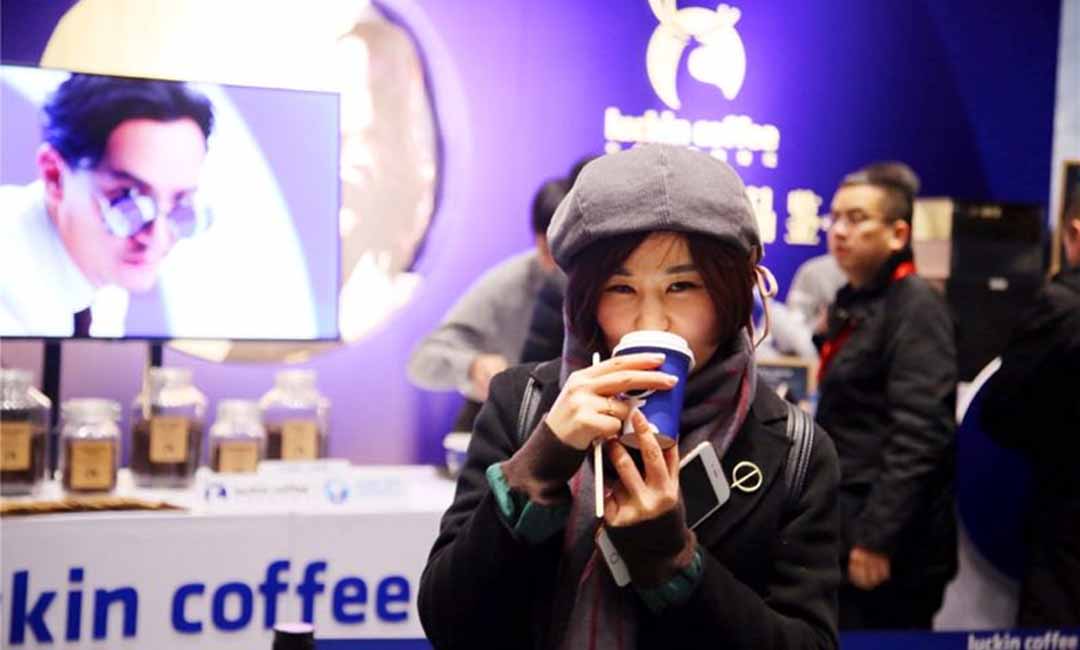The coffee market is escalating into a battleground.
Luckin Coffee, with a relentless expansion, is expected to surpass 15,000 stores by the end of this year. Cotti Coffee, a rising force, achieved over 6,000 stores within a year, and is aiming to establish 20,000 stores in three years. Following closely are local brands like Lucky Cup (under Mixue Bingcheng), Jenny X Coffee (under Auntea Jenny), Nowwa Coffee, Manner Coffee, and M Stand.
As local coffee brands gain momentum, does this exert pressure on pioneers like Starbucks, which has been quietly developing for years?
Quite the contrary.
After the emergence of Luckin and its impact on the Chinese coffee market, Starbucks China entered a period of rapid growth. Despite being surpassed by Luckin in store count and quarterly revenue, Starbucks still maintains a significant lead in profitability.
The reason lies in Luckin’s low-price and subsidy-driven strategy, which has expanded the coffee consumer base. However, Luckin’s takeout coffee model doesn’t directly compete with Starbucks’ social coffee experience.
The Chinese coffee market is sizably extensive and holds considerable growth potential. Following the initial growth phase, the market’s development will gain clarity, with various segments such as social coffee shops, takeout coffee shops, fast food coffee, tea-based coffee shops, and convenience store coffee shops each adopting distinct business models, product positioning, and pricing strategies.
Consequently, challenges faced by Cotti against Luckin, Pacific Coffee trailing Starbucks and Costa Coffee, and the distinctive Manner fading away all represent pivotal mid-game scenarios in this dynamic industry.
The coffee boom in China
Where there’s competition, there’s profit.
The business world operates on the same principle, and in the coffee industry, a price war is in full swing.
Besides weekly RMB 9.9 (USD 1.4) coffee vouchers, Luckin recently introduced RMB 9.9 voucher packages, practically giving away coffee. Cotti, in addition to its longstanding RMB 8.8 (USD 1.24) promotion, has also begun to offer a RMB 5.59 (USD 0.83) combo and even a limited-time RMB 1 (USD 0.14) discount.
Beyond Luckin and Cotti, numerous coffee brands have joined the price war—giving the impression that coffee won’t sell if it’s priced higher than RMB 9.9.
In the past, coffee prices were high, and everyone had a cup of milk tea while working or shopping. Now, coffee prices (for end consumers) are lower than milk tea, prompting young people to switch their preferences.
Cotti’s intimate struggle with Luckin is a “legend” in Chinese business history. Lu Zhengyao, co-founder of Luckin, was forced out due to financial fraud, and Cotti, founded by Lu with a new team, made a strong comeback, challenging Luckin’s dominance.

In the face of Cotti’s challenge, Luckin didn’t yield an inch. The restructured Luckin, with comprehensive adjustments in shareholders, management, and business models, emerged as a new company. After crossing the 10,000-store threshold in June, it now has over 13,000 stores and is expected to surpass 15,000 stores by the end of this year. By leveraging excellent product and brand strength, it firmly holds over 50 million coffee consumers.
The latest financial results revealed that in Q3 2023, Luckin Coffee’s revenue reached RMB 7.2 billion (USD 1.01 billion), an 84.9% year-on-year increase, with an operating profit of RMB 962 million and an operating profit margin of 13.36%.
Cotti’s growth is even faster. Opening its first store in October 2022, it surpassed 6,000 stores in just one year and is aiming to operate 20,000 stores by the end of 2025. It is little wonder that the market is watching with admiration.
Luckin ignited the local coffee industry. Before this, coffee trends were largely represented by Taiwanese cafes like Illy, European and American cafes like Starbucks and Costa, and Korean cafes like Maan Coffee, each enjoying popularity for several years.
But local coffee chain brands such as Luckin, Cotti, Lucky Cup, Jenny X Coffee, Nowwa, and Manner are now becoming a formidable force after undergoing years of development.
In the past three years, there has been a surge in the establishment of startup coffee brands, gaining significant attention from the primary market. Projects that have received funding exceeding RMB 100 million (USD 14.1 million) include Seesaw, Algebraist Coffee, Minism Coffee, Starparot, Lucky Cat Coffee, and Coffee Z, among others.
Beyond the fresh coffee market, the often-overlooked instant coffee and ready-to-drink coffee markets have birthed industry leaders like Saturnbird Coffee and emerging brands like Chalatte Coffee, Tasogare, and more.
Although the coffee craze in China lagged behind tea for several years, the current market trends indicate that the development momentum of the Chinese coffee market is no weaker than that of the country’s tea market.
An even more favorable environment for Starbucks
Amid the emergence of new local coffee brands, Starbucks not only remains unpressured but, in fact, continues to thrive.
As of October 1, 2023, in the fourth quarter of the 2023 fiscal year, Starbucks China added 326 stores, bringing its total to 6,806, representing a 13% year-on-year increase. This equates to adding four stores daily, setting a new historical record.
In Q4 2023, Starbucks China’s revenue was USD 840.6 million, 15% higher than the previous year after excluding exchange rate effects. The full-year revenue reached USD 3 billion, an 11% year-on-year increase.
It can be said that while Starbucks faces global consumption challenges, its Chinese business is driving overall growth. In the latest quarter, Starbucks globally added 816 stores, with 40% in China.
In Q4 2023, Starbucks’ revenue was USD 9.373 billion, an 11.4% year-on-year increase, with full-year revenue growing by 12% to USD 36 billion. The China region undoubtedly contributed significantly to this impressive growth.
In 1966, Dutch coffee trader Alfred Peet relocated to the US and opened a shop in Berkeley, California, introducing high-quality Arabica coffee and dark roasting techniques. Three coffee enthusiasts apprenticed under Peet, opening the first Starbucks store in Pike Place Market, Seattle, in 1971.
Howard Schultz, who supplied coffee grinders to Starbucks, inspired by Italian cafes, opened the boutique coffee shop “Il Giornale.” Later, Schultz fundraised to acquire Starbucks, merging it with Il Giornale, forming the world’s top freshly ground coffee retail brand.
Excellent business expansion capabilities and a focus on maximizing single-store efficiency propelled Starbucks to fame. After going public in 1992, Starbucks expanded across the US, upgrading to a global brand within a few years. In 1998, it entered the UK, Malaysia, New Zealand, and Thailand, followed by the Chinese market in 1999.
Starbucks accelerated the decline of Taiwanese coffee shops, established European and American coffee shops as market leaders, and resisted the attack of third-generation Korean coffee shops, mainly represented by Maan Coffee.
For a long time, talking about visiting a coffee shop in China was practically synonymous with Starbucks in the minds of consumers. A search for coffee shops on a map app would likely have Starbucks at the top of the list.
Chinese chain brands look up to Starbucks. Luckin, previously dubbed the “Chinese version of Starbucks,” initially aligned closely—though, after several years of exploration and adjustment, it has become less like Starbucks.
As coffee shops change hands between generations, apprentices innovate, and Starbucks—the master—is calmly entering its best development phase.
In 2017, Luckin was born, challenging Starbucks at every turn. However, the well-established Starbucks proved more resilient than outsiders imagined, simultaneously accelerating its expansion. On average, Starbucks added over 600 stores annually, surpassing any previous period.
Starbucks’ “zen” attitude, anchored by several classic products, was gradually disrupted by Luckin’s product strength. In recent years, new products have emerged, with plans for premium coffee in the pipeline.
For many years, the lofty Starbucks did not offer delivery. Now, it is expanding to offer online orders, in-store pickups, delivery services, and e-commerce.
A multi-tier battle in the coffee market
In a vast sea, the bigger the fish, the stronger the fight—Starbucks and Luckin understand this well.
China’s coffee market has become multi-tiered, and competition is fierce. Luckin, Cotti, and other coffee brands are engaged in price wars, while brands such as Manner, Tims, and M Stand are entering the market, generating market volume, and cultivating Chinese coffee consumption habits. These trends all coalesce to create a burgeoning population of coffee drinkers in China.
Once people acquire a taste for coffee, they might step into Starbucks, experiencing a distinct coffee-drinking atmosphere. Moreover, the coffee market has been multifaceted from the beginning. While Starbucks steadfastly maintained its positioning by showing restraint in discount usage and utilizing value-based pricing, a strategy which gradually gained acceptance, newer brands like Luckin focused on serving takeout coffee in smaller stores, naturally expanding room for low-cost operations.
In 2013, the size of the Chinese coffee market was only in the tens of billions of RMB. It is expected to exceed RMB 600 billion (USD 84.7 billion) in 2023, a nearly 40-fold increase in ten years.
Currently, the per capita coffee consumption in China is 12 cups per year, two cups more than in 2019. However, compared to the annual average of 380 cups in the US, 300 cups in Korea, and 200 cups in Japan, there is still significant room for growth.
With Generation Z consumers entering the fray, China’s coffee market will continue to transition and expand. As long as the Chinese coffee-drinking population grows normally and per capita cups increase slightly, it will be a massive incremental market, with an imminent RMB 1 trillion (USD 141.36 billion) breakthrough.

Starbucks plans to continue expanding its stores in the Chinese market, aiming to open 9,000 stores by 2025. In other words, in the next three years (2023–2025), Starbucks China’s new store openings will be equivalent to half of the total number of stores in the previous 23 years.
Leading players like Starbucks, Luckin, Cotti, supported by veteran Costa, and newcomers Manner, Tims, M Stand, are gearing up for a new round of store opening competitions.
Thus, the Chinese coffee market is seemingly transitioning from a period of popularization toward maturity.
As the mid-game continues to unfold, market segmentation will become more apparent: social coffee shops led by Starbucks and Costa, takeout coffee shops led by Luckin and Cotti, fast food coffee shops represented by McCafe (McDonald’s) and K Cafe (KFC), tea coffee shops like Lucky Cup and Jenny X Coffee, and convenience store coffee shops in 7-Eleven, Family Mart, and Lawson.
But in this coffee gold rush, not everyone can be a winner.
Some participants have already started falling behind, with independent coffee shops taking the brunt. Brands like Luckin, recognizing the opportunity, have introduced franchise models, consolidating these mature but scattered coffee shops.
The superstore model of Maan Coffee, caught in a crossfire, struggles to find a balance between functionality and operational efficiency, leading to the closure of some stores in Beijing, Suzhou, Nanjing, Chongqing, Wuhan, and other cities.
Backed by China Resources, Pacific Coffee, once known as the “second-largest coffee chain in China,” is also facing the embarrassment of closing numerous stores in the current coffee industry boom, with rumors of a potential sale.
The upcoming battle and elimination are bound to become more intense.
This article was adapted based on a feature originally written by and published on Zebra Consumption Institute (WeChat ID: banmaxiaofei). KrASIA is authorized to translate, adapt, and publish its contents.

